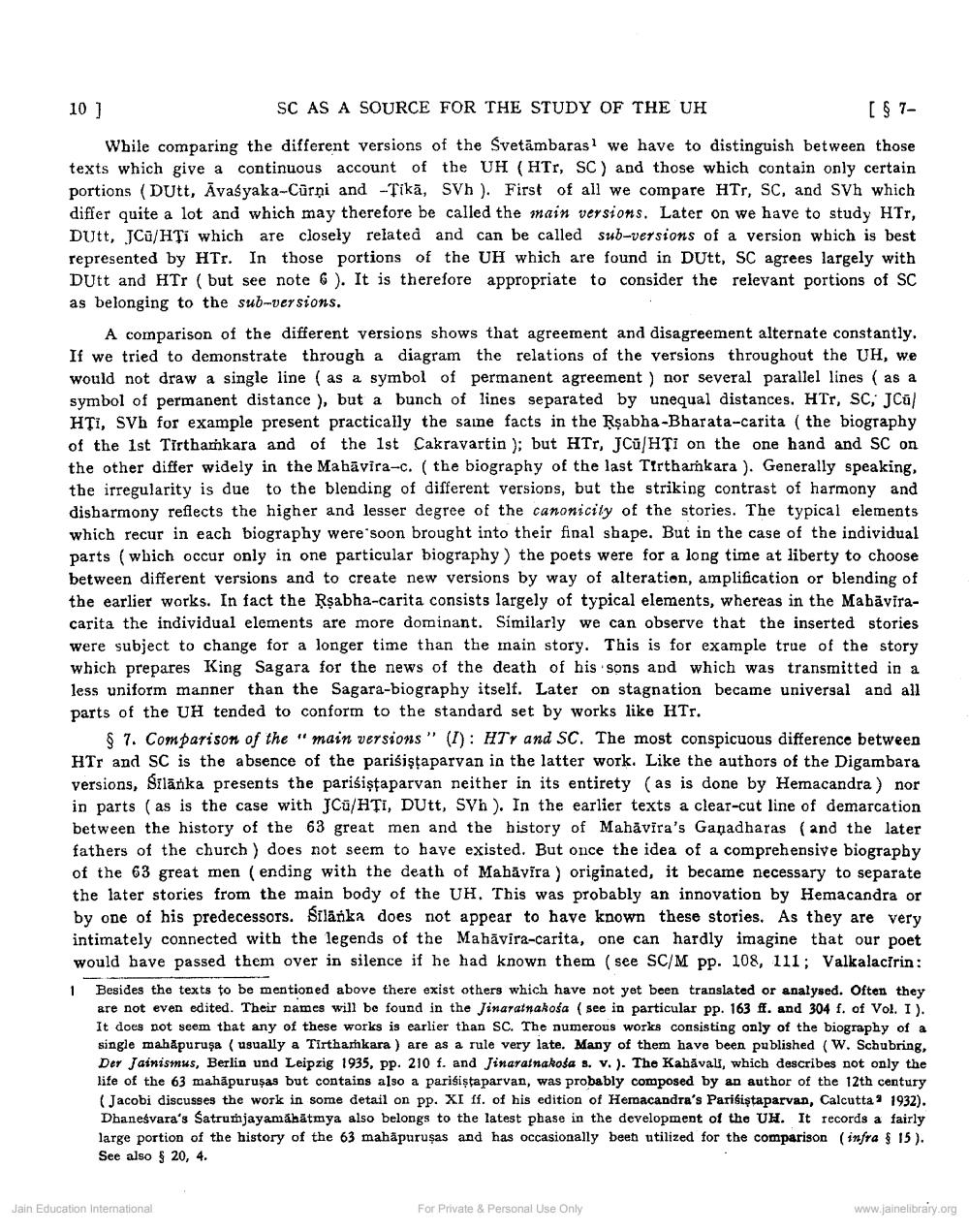________________
10 ]
SC AS A SOURCE FOR THE STUDY OF THE UH
[$ 7
While comparing the different versions of the Svetāmbaras! we have to distinguish between those texts which give a continuous account of the UH (HT, SC) and those which contain only certain portions (Dutt, Āvasyaka-Cūrņi and -Tikā, SVh). First of all we compare HTr, SC, and SVh which differ quite a lot and which may therefore be called the main versions. Later on we have to study HTT, Dutt. TCu/HTi which are closely related and can be called Sub-versions of a version which is best represented by HTr. In those portions of the UH which are found in Dutt, SC agrees largely with Dutt and HTr (but see note 6 ). It is therefore appropriate to consider the relevant portions of SC as belonging to the sub-versions.
A comparison of the different versions shows that agreement and disagreement alternate constantly. If we tried to demonstrate through a diagram the relations of the versions throughout the UH, we would not draw a single line (as a symbol of permanent agreement) nor several parallel lines (as a symbol of permanent distance ), but a bunch of lines separated by unequal distances. HTr, SC, JCā/ HȚI, SVh for example present practically the saine facts in the Rşabha-Bharata-carita ( the biography of the 1st Tirtharkara and of the 1st Cakravartin); but HTr, JCū/HȚI on the one hand and SC on the other differ widely in the Mahāvira-c. (the biography of the last Tirthamkara ). Generally speaking, the irregularity is due to the blending of different versions, but the striking contrast of harmony and disharmony reflects the higher and lesser degree of the canonicity of the stories. The typical elements which recur in each biography were soon brought into their final shape. But in the case of the individual parts ( wbich occur only in one particular biography) the poets were for a long time at liberty to choose between different versions and to create new versions by way of alteration, amplification or blending of the earlier works. In fact the Rşabha-carita consists largely of typical elements, whereas in the Mabăviracarita the individual elements are more dominant. Similarly we can observe that the inserted stories were subject to change for a longer time than the main story. This is for example true of the story which prepares King Sagara for the news of the death of his sons and which was transmitted in a less uniform manner than the Sagara-biography itself. Later on stagnation became universal and all parts of the UH tended to conform to the standard set by works like HTr.
$ 7. Comparison of the " main versions" (I): HTY and SC. The most conspicuous difference between HTr and SC is the absence of the parisistaparvan in the latter work. Like the authors of the Digambara versions, Silanka presents the parisistaparvan neither in its entirety (as is done by Hemacandra) nor in parts (as is the case with JCū/HTI, DUtt, SVh). In the earlier texts a clear-cut line of demarcation between the history of the 63 great men and the history of Mahavira's Ganadharas (and the later fathers of the church) does not seem to have existed. But once the idea of a comprehensive biography of the 63 great men (ending with the death of Mahāvīra ) originated, it became necessary to separate the later stories from the main body of the UH. This was probably an innovation by Hemacandra or by one of his predecessors. Silänka does not appear to have known these stories. As they are very intimately connected with the legends of the Mahāvira-carita, one can hardly imagine that our poet would have passed them over in silence if he had known them (see SC/M pp. 108, 111; Valkalacirin:
Besides the texts to be mentioned above there exist others which have not yet been translated or analysed. Often they are not even edited. Their names will be found in the Jinaratnakośa ( see in particular pp. 163 ff. and 304 f. of Vol. I). It does not seem that any of these works is earlier than SC. The numerous works consisting only of the biography of a single mahāpuruşa (usually a Tirthamkara ) are as a rule very late. Many of them have been published (W. Schubring, Der Jainismus, Berlin und Leipzig 1935, pp. 210 f. and Jinaratnakosa s. v. ). The Kabăvali, which describes not only the life of the 63 mahāpuruşas but contains also a pariţiştaparvan, was probably composed by an author of the 12th century (Jacobi discusses the work in some detail on pp. XI ff. of his edition of Heracandra's Parisiştaparvan, Calcutta. 1932). Dhanesvara's Satrunjayamabātmya also belongs to the latest phase in the development of the UH. It records a fairly large portion of the history of the 63 mahäpuruşas and has occasionally been utilized for the comparison (infra $ 15). See also 20, 4.
Jain Education International
For Private & Personal Use Only
www.jainelibrary.org




